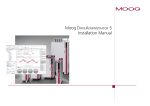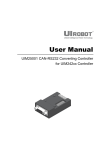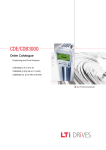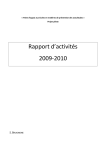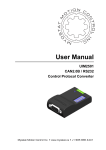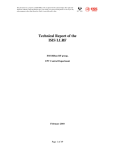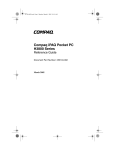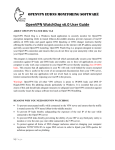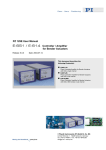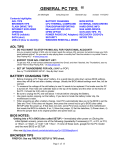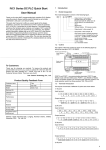Download Analysis and simulation of decentralized control system
Transcript
Design of Powerful Digital Servo-controller VLADISLAV SKORPIL, JIRI STASTNY Department of Telecommunications Department of Automation and Computer Science Brno University of Technology Purkynova 118, 612 00 BRNO, Czech Republic, CZECH REPUBLIC Abstract: - The conception of control systems is at present based on the principle of decentralized subsystems interconnected with the control centre through a communication channel. With this arrangement it is easy to extend and modify the systems but, at the same time, the demands made on the speed and capacity of transfer channels are higher. One of the companies that applied the idea of decentralized system to the control of the positioning mechanism is the Swedish firm Atlas Copco. Atlas DMC is a powerful digital servo-controller designed to control a large torque and great velocity with various application possibilities. A standard logic unit provides for easy interconnection with current control systems. The PL2 code is used for programming in the ProMOTION software. In the basic version the Atlas system enables Off-line control, the direct control of axes is provided by Online control, and in the case of higher demands on the speed of communication a special communication protocol, CAN, is used. Key-Words: Control, simulation, ATLAS-system, servo-system, PL2code 1 Introduction An intelligent current frequency-changer is used to control position, and a synchronous motor with permanent magnets on the rotor is the driving unit. From the viewpoint of versatile applicability an advantage of these servo-controllers consists in their modularity and the wide range of motors that can be connected. Synchronous motors with permanent magnets are characterized by great precision at the cost of a lower efficiency. With the current trend of decreasing prices of electronic products frequency changers are becoming an affordable control tool. 2 Analysis of the functions of the Atlas system Atlas DMC represents a new series of digital servo-systems with very efficient integrated functions, built for systems that need to control a high torque, velocity and position in industrial facilities. The unit is designed to control motors with permanent magnets and output between 0.3 and 35 kW. Three-phase motors with 230 V or 400 V ac power supply can be used. The third possible power supply, the lowest, is singlephase 115 V ac supply of 0.3 to 35 kW, currently in the stage of development. Units with direct dc supply are also available. DMC is conceived as a modular system and thus it allows mounting the units side by side (all modules are of the same height and depth) for multi-axis applications. Atlas DMC is produced in two versions: - as an independent single-axis system with an integrated power supply unit and a brake module or - for reasons of space economy and price reduction it is supplied for multi-axis applications without the integrated supply unit. Power is then supplied from the central unit. It was possible to achieve small dimensions of the servo-amplifier by applying the modern technology of switched sources. Low power losses and a thorough thermal design eliminated the need for external fan cooling, which resulted in increased reliability. Atlas DMC is based on the 16/8-bit Intel 980C196KC processor, which has a wide range of functions. This enhances the DMC potentials compared to other conventional R/D converters. The DMC unit is made up of 4 items: power supply board, processor board, I/O board and an optional “Integrated Power Supply Board”. The unit can be further extended by several adjustable cards, which give the system much flexibility. The power supply part utilizes IGBTs (Insulated Gate Bipolar Transistor), which provide the separation of ac supply without using separating transformers. An autotransformer can be used to adapt the supply voltage. The output curve is sinusoidal with 10 bits per sample, provided a standard I/O board is used. Measuring in two stages is currently used with the usual transformation. Cyclic switched signal with an efficiency of 96-98% and low efficiency is used. Modular design reduces production costs and physical dimensions. Atlas DMC uses a simple speed feedback as the feedback element. Position and revolutions are read by a resolver integrated directly on the motor. The speed and position are given directly by the resolver.. The standard version provides for two resolvers for absolute positioning. This enables either positioning in two axes with reliable rotation or positioning of the master/slave type, where the second resolver is the first to execute the instructions. The second resolver can also be used for compensating for slippage during shifting, for setting the position manually, for absolute multi-ROTATION positioning or as another two analog inputs. Absolute measuring eliminates the risk of impulse losses, which can occur in the system of incremental sensor. DMC can be used in high-speed applications. The integrated function of the programmable controller enables reading 12 (to 17) digital inputs, activating 6 (to 10) digital outputs and two relay outputs. Two programmable analog inputs can be used, for example, to set externally the revolutions, momentum, acceleration, etc. Two analog outputs are used for setting the regulator or for analog interfaces of further devices (they can, for example, indicate the regulator deviation of position, speed, momentum, etc.). Logic inputs and outputs are made such that they are resistant to industrial interference and shortcircuiting. The standard logic (24V) provides for easy interconnection with current control systems (PLC, industrial PC, etc.) without the necessity of signal adaptation. A standard feature of servo-amplifiers is the RAM 8 k Byte back-up memory for storing the user program. 3 Programming Programming is conducted in the PL2 code in the PproMOTION software running under the Windows operating system. The Atlas DMC PL2 code is an extension of the Atlas Copco Controls Language, which was developed as an interpretive language. Like other higher programming languages it contains ifinstructions, creation of subprograms and macros, arithmetic and logic operations. It also provides for handling the inputs and outputs, setting the internal timer, controlling the interrupt, changing the parameters of servoamplifier (regulator), setting different modes of operation (synchronization, flying synchronization, non-linear transfer), etc. All the instructions in the PL2 language can be used On-line (with the programs running), which simplifies the development and debugging of the application program. The ProMOTION environment includes the ECT (Editor/Tester/Compiler) module, which enables editing, compiling, copying and testing the program. This editor supports the PL2 syntax. If in the course of compiling the PL2 code a syntax or version error appears, the compiler will mark the given part of the code and thus initiate error correction. Other modules of the ProMOTION environment are: the FixIT installation module, the module for actual execution of the PreSIZE industrial programs with a database containing data on motors, controller, power-supply units, drives, mechanisms and linkages, and the ProFILE module, which represents a graphics instrument for experimenting with different motion profiles. In real time, the ProFILE module is interconnected with the PreSIZE module for the analysis of the system being designed. 4 Application possibilities The Atlas system is an efficient means for managing position control. It is suitable in particular for applications where precision and speed are required. It can be used with advantage in repeated simple shifting operations, where the control motor itself has the function of a programmable automaton and power electronics. It is very reliable for combined movements, for example those of a stowing machine or conveyer. A great advantage of this system lies in the possibility of setting the controller via the program. The directly entered values of P.I.D. constants provide for the best possible setting of the control loop and thus for highly satisfactory control. Creating a model of the schematic of control loop the optimum values of the constants being set can be obtained by simulation. 4.1 Off-line control The basic version of the Atlas system is designed for type Off-line control. A program is created in the development environment and after compilation the resultant product is transferred to the servo-amplifier. If any parameters of position, speed or PID regulator need to be adjusted, it is necessary to adjust the source program and transfer it again into the servo-amplifier. For the time of adjustment the production is discontinued. This procedure can be applied to simple movements in both lot and mass production. A change in the parameter can be solved not only by overwriting the value. One possible solution is to set the parameters stepwise, using digital inputs. Admissible values are redefined in the source language and then they are only selected using an external device (either manually or electronically). Another possibility is setting the parameters by means of analog inputs, where voltage can be changed within 0 – 10V. In the case of slower events the parameters can be changed by setting the registers via the RS232 line, the values being set, for example, every tenth of a second or with an even longer period. To determine position and speed, interpolation is used between the periods. 4.2 On-line control In the case of on-line control of axes it is necessary to supply every millisecond data on the position and speed (two data) of the given axis in order to have a flowing and flexible rapid motion. These data have to be transferred in a 32-bit word. With these initial conditions satisfied, a transmission channel of the following capacity must be available: K > x where K is the capacity in bit/s and x is the number of axes that are being controlled. The transmission capacity must be increased by the transfer of control characters. To control the manipulator in three axes, a minimum of 192 kbit would be necessary. Using a standard series line, which in the Atlas system enables a maximum speed of 9600 bit/s, this control is not quite possible. This capacity can be used for the transmission of a compiled program or, for example, in series production to change the position, revolutions, etc (between the production of individual pieces). When transmitting more values it is necessary to stop the running program, change the setting and then to restart with the changed parameters. Because of the growing demands on the speed of communication it is necessary to adopt newer communication standards. CAN is one of such satisfactory communication protocols. 4.3 CAN bus The CAN (Controller Area Network) communication protocol is based on the OSI model complying with the ISO standard. Thanks to its reliability and very good hardware support on the level of communication control units, CAN is increasingly being used in various industrial applications. The ATLAS Copco Controls company also comes with a new module, which replaces the original slow RS232 communication by a type CAN communication. In principle, the CAN communication is of the multi-master type. The message transmitted to the bus does not contain any information about the target station (addressee identification) but only the identification number of the transmitting station, which is different for every station. The identifier includes not only the message content but also the bus-access priority. This method enables sending the message from one station to another or to several stations at the same time (broadcast). The actual transmission and reception of the message frame and possible repetition are performed by the respective CAN control unit, which is only parameterised from the CPU. The CAN communication protocol does not require any physical addressing of the target (reception) nodes. A node that wants to transmit (CPU) sends to the CAN controller the data to be transmitted and the identifier of this node. The whole message is then created by the CAN control unit, which will provide bus access and message dispatch. The moment the CAN control unit recognizes that another node is sending a message that has a higher priority than its own message has, it will switch to the reception mode. All CAN control units can recognize the correctness of received data. Some control units are equipped with a means for message filtering so that they only inform their processor about the message received if the message identifier is identical to the identifier adjusted for reception. The CAN protocol supports two types of message (frame), namely CAN 2.0A and CAN 2.0B, the difference between the two being in the length of identifier (ID). CAN 2.0A has ID = 11 bits and CAN 2.0b has ID = 29 bits. All the control units used on one bus must support the extended CAN 2.0B format. In principle, the transmission of every message is a “broadcast”. The message is received in the CAN control units of all the other nodes irrespective of whether the receivers have their identifier filtering adjusted or not. Every receiver that has received the message error-free will send the active (dominant) bit in the ACK array. This is to say we are concerned with acknowledged “broadcast”. This means that each receiver in the network must respond to every transmitted message and do so either in the ACK array or by sending the error message. For this kind of communication the Atlas Copco company has developed a special module which enables connection to world communication standards. For the sake of simpler but equally fast connection of the external bus, Atlas Copco has developed an internal CAN bus, which is used for internal communication of individual modules. 5 Simulation model in the MatlabSimulink environment In the elements that simulate the motor the parameters of an SBL4-0400 motor were entered. The position shift is set to one revolution (8197 increments). Simulation results: Position vs. time, Revolutions vs. time, Momentum vs. time, Proportional error vs. time, Integration error vs. time, Derivative error vs. time. 6 Conclusion The application possibilities of the servocontroller are very broad. The Atlas system can be modified to keep pace with the development of new technologies and with increasing users’ demands. This is mainly evident on the development of new communication standards. The creation of a new module for communication via the CAN bus and the connection to buses of the type of Profibus, Open-CAN, etc., have led to new application possibilities. In the first place it is the application possibility in systems with continuous positioning in several axes simultaneously. This in turn entails the necessity of developing an environment for the design and realization of control programs for On-line control. But the tried and tested application of DMC in both simple and complicated applications of combined shifting and driving should not be forgotten. To provide all the necessary functions in these cases the existing possibilities of this system are fully satisfactory. Acknowledgement This research was supported by the grants: No 102/03/0434 Limits for broad-band signal transmission on the twisted pairs and other system co-existence The Grant Agency of the Czech Republic (GACR) No CZ 400011(CEZ 262200011) Research of communication systems and technologies (Research design) No IS 432 124 (2124/2003/F1) Modernizing and innovation of telecommunication services education (grant of the Czech Ministry of Education, Youth and Sports) References: [1] ATLAS DMC: User’s Manual 2.0. Atlas Copco, 1995 [2] ATLAS DMC: User’s Manual, First Edition, Atlas Copco, 1994 [3] TG drivers: Digital Servocontrollers Atlas Copco . Atlas Copco, 1995.





